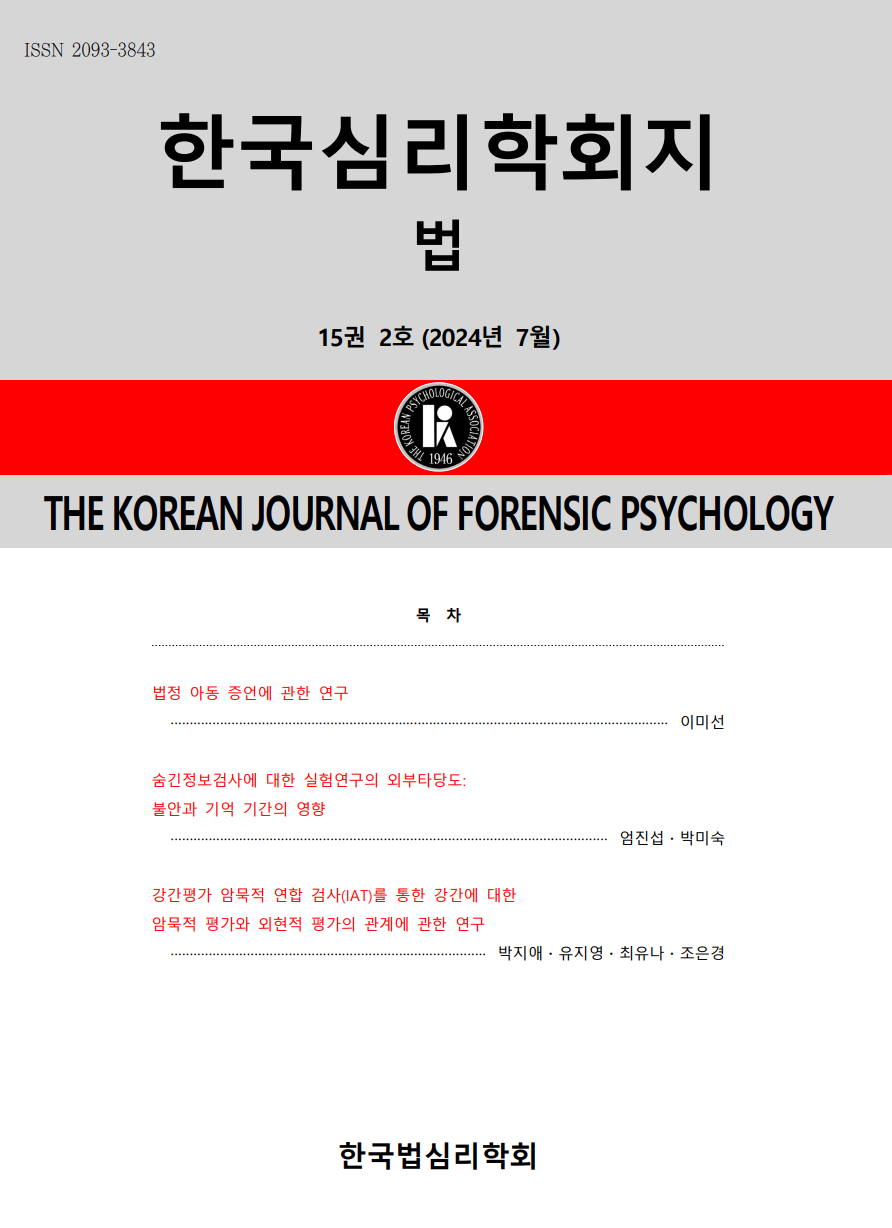open access
메뉴
open access
메뉴 ISSN : 2093-3843
ISSN : 2093-3843
Judgment and decision-making studies have shown that people are easily influenced and biased by information irrelevant to the object of judgment. There is a great deal of research that indicates that bias exists in the legal judgment scene. One of them is a bias induced by defendants’ character evidence. This study examined whether cognitive activities such as discussion, counterfactual thinking, and peer assessment could reduce the bias induced by the character evidece. In Experiment 1, 121 college students were asked to give the percentage they believed the defendant to be guilty. There was no cognitive activity for the control group. There were three different cognitive activities for the experimental group: discussion, counterfactual thinking and discussion, and counterfactual thinking and peer assessment. Results showed reduction in bias for all the experimental groups, and there was no difference between them. In Experiment 2, there were 125 participants from general population for the same procedure as in Experiment 1. Results showed reduction in bias only for the counterfactual thinking and discussion group. In general discussion, we speculated the implication of the results and the reason for the difference between the two experiments.
김대성(2007). 영국에서의 형사배심재판사건의 축소화. 형사정책연구, 12, 109-133.
고민조, 박주용(2014). 베이지안 망을 이용한 법적 논증 분석. 서울대학교 법학, 55(1), 573-616.
고민조와 박주용(2019). 피고인의 성격증거가 사실인정에 미치는 영향. 한국심리학회지: 법, 10(3), 215-235.
송오섭(2019), 국민참여재판 활성화를 위한 토론회 자료집.
이광수(2008), 국민참여재판제도의 도입과 문제점. 인권과정의, 379, 59-73.
Cowan, C. L., Thompson, W. C., & Ellsworth, P. C. (1984). The effects of death qualification on jurors’ predisposition to convict and on the quality of deliberation. Law and Human Behavior, 8(1-2), 53-79.
Daftary‐Kapur, T., Dumas, R., & Penrod, S. D. (2010). Jury decision‐making biases and methods to counter them. Legal and Criminological Psychology, 15(1), 133-154.
El-Shinnawy, M., & Vinze, A. S. (1997). Technology, culture and persuasiveness: a study of choice-shifts in group settings. International Journal of Human-Computer Studies, 47(3), 473-496.
Englich, B., Mussweiler, T., & Strack, F. (2005). The last word in court-a hidden disadvantage for the defense. Law and Human Behavior, 29(6), 705-722.
Ernst, B., & Steinhauser, M. (2015). Effects of invalid feedback on learning and feedback- related brain activity in decision-making. Brain and cognition, 99, 78-86.
Glöckner, A & Engel, C.(2012). Role Induced Bias in Court: An Experimental Analysis. Journal of Behavioral Decision Making, 26(3), 272–284.
Glöckner, A., & Engel, C. (2013). Can We Trust Intuitive Jurors? Standards of Proof and the Probative Value of Evidence in Coherence- Based Reasoning. Journal of Empirical Legal Studies, 10, 230-252.
Hastie, R., Schkade, D. A., & Payne, J. W. (1999). Juror judgments in civil cases: Effects of plaintiff’s requests and plaintiff’s identity on punitive damage awards. Law and Human Behavior, 23(4), 445-470.
Janis, I. L. (1982). Decision making under stress. In L. Goldberger & S. Breznitz (Eds.), Handbook of Stress: Theoretical and clinical aspects (pp.69–87). New York: NY: The Free Press.
Jessup, L. M., Connolly, T., & Galegher, J. (1990). The effects of anonymity on GDSS group process with an idea-generating task. Mis Quarterly, 14, 313-321.
Kerwin, J., & Shaffer, D. R. (1994). Mock jurors versus mock juries: The role of deliberations in reactions to inadmissible testimony. Personality and Social Psychology Bulletin, 20(2), 153-162.
Kocher, M. G., & Sutter, M. (2006). Time is money—Time pressure, incentives, and the quality of decision-making. Journal of Economic Behavior & Organization, 61(3), 375-392.
Larrick, R. P. (2004). Debiasing. In D. J. Koehler & N. Harvey (Eds.), Blackwell Handbook of Judgment and Decision Making, (pp. 316–337). Blackwell Publishing Ltd.
Leighton, J. P. (2006). Teaching and assessing deductive reasoning skills. The Journal of experimental education, 74(2), 107-136.
London, K., & Nunez, N. (2000). The effect of jury deliberations on jurors’ propensity to disregard inadmissible evidence. Journal of Applied Psychology, 85(6), 932-939.
Nunez, N., Dahl, M. J., Tang, C. M., & Jensen, B. L. (2007). Trial venue decisions in juvenile cases: Mitigating and extralegal factors matter. Legal and Criminological Psychology, 12(1), 21-39.
Park, J. (2017). ClassPrep: A peer review system for class preparation. British Journal of Educational Technology, 48. 511-523.
Payne, J. W., Bettman, J. R., & Luce, M. F. (1996). When time is money: Decision behavior under opportunity-cost time pressure. Organizational behavior and human decision processes, 66(2), 131-152.
Perry, T. S. (1992). Electronic mail-E-mail at work. Spectrum, IEEE, 29(10), 24-28.
Schulz-Hardt, S., Frey, D., Lüthgens, C., & Moscovici, S. (2000). Biased information search in group decision making. Journal of personality and social psychology, 78(4), 655-669.
Sniezek, J. A., & Henry, R. A. (1989). Accuracy and confidence in group judgment. Organizational behavior and human decision processes, 43(1), 1-28.
Stasser, G., & Titus, W. (1985). Pooling of unshared information in group decision making: Biased information sampling during discussion. Journal of personality and social psychology, 48(6), 1467-1478.
Sutter, M., Kocher, M., & Strauß, S. (2003). Bargaining under time pressure in an experimental ultimatum game. Economics Letters,81(3), 341-347.
Svenson, O., Edland, A., & Slovic, P. (1990). Choices and judgments of incompletely described decision alternatives under time pressure. Acta Psychologica, 75(2), 153-169.
Tversky, A., & Kahneman, D. (1986). “Rational Choice and the Framing of Decisions,” The Journal of Business 59(4), part 2, S251-S278.
Valacich, J. S., Jessup, L. M., Dennis, A. R., & Nunamaker Jr, J. F. (1992). A conceptual framework of anonymity in group support systems. Group Decision and Negotiation, 1(3), 219-241.
Weisberg, H. (2010). Bias and Causation: Models and Judgment for Valid Comparisons. Hoboken, NJ: John Wiley and Sons, Inc.